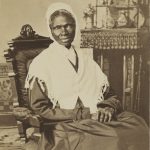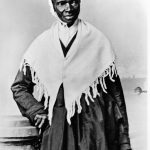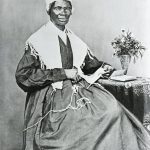Sojourner Truth was born into slavery as Isabella Bomfree in 1797, just after the Revolutionary War, in New York. Truth suffered various forms of abuse and was forced to do hard physical labor while a slave. After escaping slavery with her daughter, an abolitionist family bought her freedom and Truth moved to New York. Truth’s spirituality grew as she became a devout Pentecostal Christian. Truth’s spiritual encounter with the holy spirit inspired her to begin her speaking career and she vowed to “preach the truth.” This vow inspired her to change her name to Sojourner Truth and she participated in many religious revivals in the middle of the Great Awakening (Michals, 2015). Although Truth did not know how to read or write, she was a dynamic speaker particularly concerned with controlling the way in which she was visually portrayed. The following photographs contrast the ways that black women at the time were typically visually portrayed. In these photos, Truth is pictured doing many things like holding a book, posing as if she is knitting, her posture is poised, her facial expression suggests that she must carry a great deal of wisdom, and a number of other things. In other words, Truth is depicted as a respectable and wise old women from the way she is dressed in refined, polished clothing to the way she positions her body. Her portrayal challenges the tendency in America to equate black women as property and anything but respectable women. Through her photographs, Truth asserts the right black women have to be considered beautiful. Truth is reclaiming the humanity and womanhood of black women and presenting one of the first images in America that emphasize this unpopular and unconventional message.




